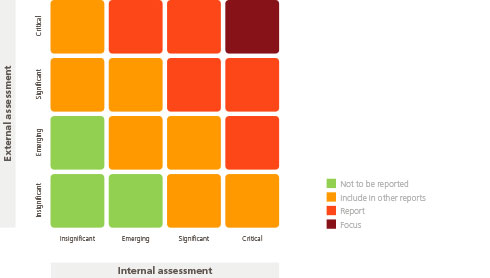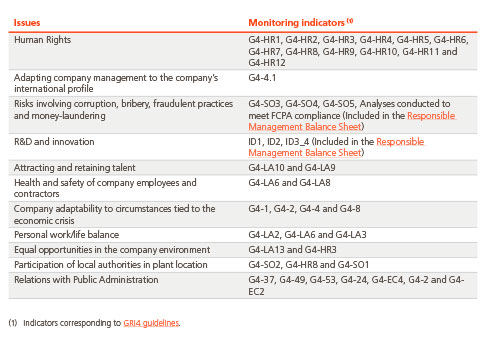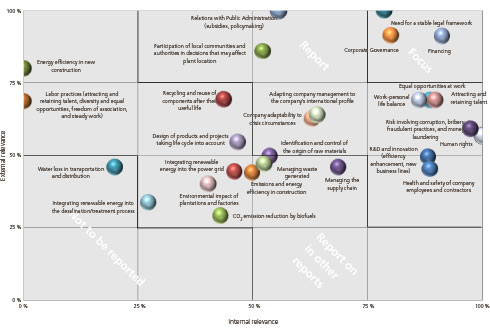 Abengoa
Abengoa
Annual Report 2013
- Corporate Social Responsibility
- About this report
- Principles governing this report
In order to identify material matters, determine the content of the report and guarantee the quality of the information contained herein, Abengoa has applied the following:
- The three principles established by the AA1000AS Standard: inclusivity, materiality and responsiveness.
- The four principles of the GRI guidance in defining report content: materiality, stakeholder inclusiveness, sustainability context and completeness.
- The principles for defining quality in report preparation: balance, clarity, accuracy, timeliness, comparability and reliability.
These principles are all interrelated, with the company choosing materiality as the cornerstone upon which the others rest.
Materiality and relevance
The information contained in CSRR13 covers those aspects and indicators that reflect the significant social, environmental and economic impacts of the company or any such aspects or indicators that could substantially influence the assessments and decisions of stakeholders. This means any information which, if omitted or distorted, could influence the decisions or actions of the stakeholders of the reporting company. To ascertain which matters are material and relevant to the company and its stakeholders, Abengoa conducts a yearly materiality analysis.2
Stakeholder inclusivity and engagement
Abengoa identifies its stakeholders and takes them into account when defining its strategy. In addition to maintaining fluid ongoing dialog with them, the company endeavors to address and respond to all their expectations and concerns in its annual report.
In 2013, Abengoa conducted interviews with 22 stakeholder representatives selected by the members of the internal committee in charge of analyzing the company's material issues3 for the purpose of taking an in-depth look at stakeholder perception of the company, the challenges it faces, and stakeholder expectations in regard to how these challenges should be approached.
Furthermore, for the sixth consecutive year since 2008, Abengoa was assessed by the Independent Panel of Experts on Sustainable Development (IPESD). This panel voices the views and opinions of company stakeholders and ensures that Abengoa conveys stakeholder-relevant information in its report. The IPESD also offers advice on how the company should handle these matters accordingly. Abengoa's responses to the questions raised by the IPESD were verified externally by KPMG and were awarded a reasonable level of assurance4.
Responsiveness
Abengoa has a variety of resources and tools in place for responding to the concerns and interests of its stakeholders. The company has made every attempt to ensure that the information requested by its stakeholders through its report is as relevant and accessible as possible for the parties concerned. The company therefore has a Strategic CSR Plan which defines the sustainability framework and guidelines the company must follow through a range of actions intended to integrate stakeholder expectations into company strategy.
Along these lines, in 2011 the company devised a Responsible Management Balance Sheet, comprising a selection of CSR-relevant indicators and reported periodically since then, thus enhancing the trust of company stakeholders and enabling them to analyze changes in key figures. In 2013, via the corporate website, the company published the responsible management balance sheet containing data for the first half of the year which were verified by an independent third party. The company also has an Integrated Sustainability Management System (ISMS) in place, bringing together all material information relating to sustainability, thereby making the task of measuring and controlling company performance more accurate and, consequently, improving company management and decision- making5.
Completeness
Abengoa attempts to provide full coverage of all material data and aspects significant to its stakeholders so they can evaluate the company's performance over the period covered by this report.
Sustainability context
Throughout this report, Abengoa assesses its performance in terms of the contribution made to its stakeholders, to the communities in which it operates and to the environment. Over the course of 2013, the company also repeatedly communicated and disclosed aspects relating to sustainability so as to raise awareness among its stakeholders and society at large of the imminent need to ensure that further progress is rooted in sustainable economic growth that will empower future generations to enjoy the same resources available to us at present.
Principles governing the quality of the information reported
The aim in preparing this report was to reflect the information in keeping with the principles for defining report quality stipulated by the GRI.
Balance
This report provides information on positive aspects, areas in which performance can be improved and also on the company's challenge. The process of identifying material issues (see section on Materiality) also helps us draw up the report. Furthermore, the opinion of the IPESD, as published in this report, affords the reader a picture of how society at large perceives the company's performance.
Comparability
The content and data published in this report allow readers to analyze changes in the company and how it has evolved. Comparative figures have therefore been included for the previous year, with any changes in calculation methods being duly indicated.
Accuracy
The independent review which this report underwent assures both accuracy of quantitative data and confirmation of evidence and appropriate context for qualitative information.
Timeliness
The report must be presented on time and according to a regular schedule so that stakeholders may make informed decisions based on the right information. Abengoa has been publishing its annual Corporate Social Responsibility Report since 2003. All of these reports are available on the corporate website.
Clarity
The information must be presented in an understandable and straightforward manner so as to ensure that the report can be understood by readers. Abengoa publishes a pdf version and a web version of its report, both of which are available to the public, and sends the report out to its shareholders, main customers, the media and press, responsible investment institutions and any other interested parties who so request.
In preparing the CSRR, Abengoa has taken on board the recommendations from stakeholders on how the information should be presented. This report also includes a glossary containing definitions of technical terms and any others with which readers may be unfamiliar.
Reliability
The information and procedures followed in preparing a report should be gathered, recorded, compiled, analyzed and disclosed in such a way that they may be subject to examination, and which establishes the quality and materiality of the information.
Analyzing materiality at Abengoa
For the sixth year in a row, Abengoa conducted a materiality analysis in 2013 in line with the requirements of the GRI G4 Guide6. This process involves examining issues of relevance to Abengoa's stakeholders (external perspective) and those that are relevant for company business (internal perspective). Making use of both perspectives is essential in upholding the principle of inclusivity defined under the AA1000AS (2008) Standard.
Furthermore, the distribution of these matters along the company value chain was also taken into account in the 2013 analysis. In other words, the importance for the company of issues deemed to be of material relevance for stakeholders was analyzed while also taking into consideration the entire value chain in order to factor in what is relevant as well as where it is relevant.
The following sources were taken into account in drawing up the list of material issues for stakeholders:
- International reporting standards, primarily the GRI and AA1000AS (2008).
- Best practices analysis of the leading companies in the fields of energy and environment.
- Socially responsible investors. Analyzing indexes such as the DJSI and the FTSE4Good enables us to pinpoint material issues for investors and shareholders alike.
- International initiatives, such as the UN Global Compact and Caring for Climate. These and other voluntary agreements make up a set of principles that impose commitments on the company. These commitments are assessed every year, allowing the company to identify new material issues.
- Analyzing readers' reactions to the report for the previous year, which are received through the communication channels set up for this purpose.
- The press and media, by analyzing press coverage and presence of Abengoa. This enables the company to identify CSR-related aspects that received the most attention from the media.
- Endorsers. The public documents of independent social and sector-specific (energy and the environment) associations and organizations involved in areas of interest to Abengoa and its activities were examined.
- Questions and recommendations put forward by the Independent Panel of Experts on Sustainable Development (IPESD).
- Interviews with stakeholders: the company has taken into account the main topics that emerged 13 through 22 interviews with stakeholders selected by Abengoa's Committee on Relevant Matters7.
- Internal committees on relevant matters attached to the different areas of the company.
- Analysis of the results of the CSR risk assessment process implemented at 52 Abengoa facilities in 2013.
- Historical record of aspects addressed by Abengoa in previous reports: material matters identified in previous reports.
And in order to analyze internal perspective and determine which matters are relevant for company business (the complete value chain) a committee on relevant matters was set up, comprising 14 employees representing different areas of the company and chaired by the director of Corporate Social Responsibility. The committee verified the company's value chain and assessed material issues for stakeholders (external perspective) and those it deemed to be material for the company and other components that make up the value chain.
Once the evaluations of both perspectives have been obtained, the results are presented using a matrix that enables us to determine which matters need to be reported in the CSRR and which do not.

Issues deemed to be more material or critical are found in the "Focus" area and must be analyzed in greater depth in the CSRR. Those found in the "Report" area should also be included in the report. In both cases, monitoring indicators have also been devised to enable the company to oversee their evolution over time.

Critical issues (Focus)

Significant issues (Report)

Relevant issues in 2013

Note 2: This chapter includes detailed information on the materiality analysis conducted in 2013 and the conclusions gathered from the same.
Note 3: This chapter includes detailed information on the materiality analysis conducted in 2013 and the conclusions gathered from the same.
Note 4: For more information, see the Independent Panel of Experts on Sustainable Development section of this report.
Note 5: For more information, see the Strategy for a sustainable future section of this report.
Note 6: Abengoa's CSRR 2013 was prepared in line with Version 3.1 of the GRI Guide; however, in order to progressively adapt the report's structure to Version 4 guidelines, the materiality procedure was carried out based on the new guide.
Note 7: The remaining interviews were held after the RMD (PAR in its Spanish acronym) was carried out for this reason were not included as a source for the list of stakeholder relevant issues.
© 2013 Abengoa. All rights reserved
